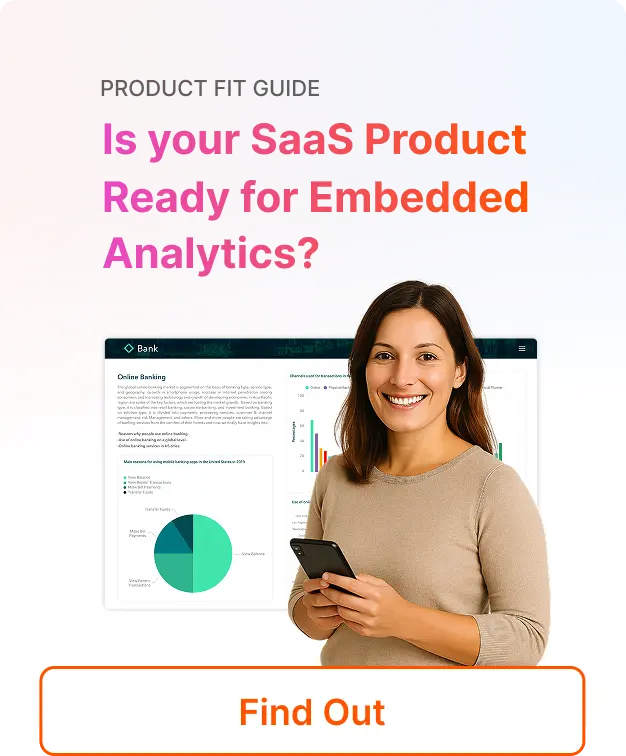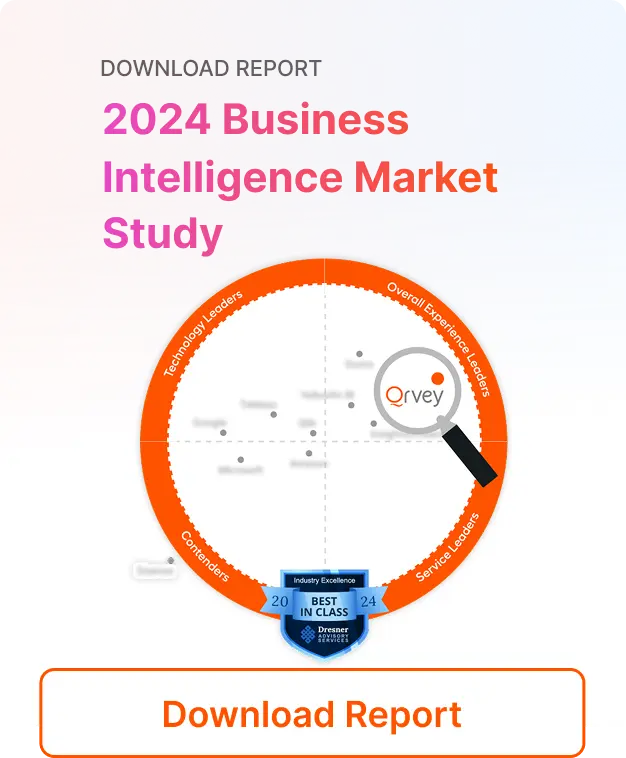From sequencing a human genome to the simple convenience of checking in at the doctor’s office via tablet, technology forever transformed the healthcare industry. And with technology comes data.
Electronic health records, medical imaging, IoT devices, and patient wearables generate massive amounts of information daily. Yet many healthcare SaaS providers struggle to turn this data deluge into actionable insights for their users.
The challenge? Building analytics capabilities that are both powerful enough to handle healthcare’s complexity and compliant enough to meet its strict regulatory requirements. This all while somehow keeping customers satisfied.
According to recent research, 67% of healthcare organizations cite “inability to analyze data effectively” as their biggest obstacle to improving patient outcomes.
For product teams building healthcare SaaS solutions, this presents both a challenge and an opportunity. How do you deliver the sophisticated analytics your users need while maintaining HIPAA compliance, protecting data security, and managing development costs?
This comprehensive guide explores the intersection of healthcare SaaS and analytics, offering practical insights for product leaders looking to enhance your solutions with powerful, compliant data analysis capabilities so you don’t break the bank or overwhelm your team.
Ahead, we’ll look at key healthcare analytics challenges, who benefits from healthcare SaaS and how, the power of analytics in healthcare SaaS, and more. By the end, hopefully you’ll be able to approach this highly complex space with more clarity and action on how to proceed.
What is Healthcare SaaS?
SaaS (Software as a Service) is a software licensing and delivery model in which software is sold via subscription and hosting is managed by the vendor. It benefits customers by alleviating the need to maintain their own servers to host the application.
Upgrades and improvements are also generally automated. As with cloud computing in general, customers don’t need to make large upfront investments in technology to get started. Meanwhile, SaaS vendors benefit from ongoing revenue streams as well as a reduction in software piracy.
The healthcare SaaS market is no slouch. It’s expected to grow to $48.78 billion in 2028 at a compound annual growth rate (CAGR) of 18.8%.
What is Healthcare Analytics?
Healthcare analytics refers to the systematic use of data and statistical techniques to examine healthcare operations, patient outcomes, and trends. It transforms raw healthcare data into actionable insights that drive informed decision-making, improved patient care, and operational efficiency.
What is Healthcare SaaS Analytics?
Healthcare SaaS analytics refers to the data-driven insights generated within cloud-based healthcare software platforms.
Platforms collect and analyze the data to provide insights to medical professionals or health organizations. Think things like: patient monitoring dashboards, population health trends, clinical decision support, or operational efficiency metrics.
Many healthcare organizations either don’t implement such healthcare analytics, or they attempt to build it themselves, costing precious time, bandwidth, and resources, without achieving the data quality and consistency they need.
That’s where an embedded analytics solution that enhances Healthcare SaaS products by providing a robust, compliant framework for both types of analytics comes into play.
Embedded analytics platforms deliver sophisticated data visualizations and interactive dashboards to your healthcare customers while simultaneously giving your product team deeper insights into how your software is being used.
This self-service analytics approach strengthens your value proposition to healthcare clients while providing the usage data you need to continuously improve your product.
What Challenges Can Healthcare SaaS Solve?
Data Security and HIPAA Compliance
Adhering to strict healthcare regulations like HIPAA regarding patient data privacy is critical to all parties in healthcare. There’s a keen interest for healthcare providers, insurance companies and patients alike in protecting sensitive information by implementing robust security measures to comply with regulations like HIPAA.
When data security is top priority, an analytics solution that protects sensitive data from things like cybersecurity threats and data breaches will be non-negotiable. That’s why embedded analytics platforms like Qrvey, enable healthcare SaaS products to operate within their own firewalls and help maintain airtight data security.
Most importantly, anything deployed into these embedded analytics platforms are retained within your own cloud, and the data will remain 100% private.
Integration Complexity
Healthcare data analytics software requires integrating data from different healthcare systems to create a comprehensive patient picture and avoid data silos.
When different analytics platforms can integrate and communicate with each other, product managers and engineers can operate cohesively without compromising data integrity or wasting time with building or maintenance.
Achieving Quality and Consistency in Healthcare Analytics (Without Burning Out)
With healthcare data, the stakes are high. The difference between high and low quality data could have monumental consequences. But healthcare data is incredibly vulnerable to quality and consistency issues. Healthcare SaaS product teams can benefit enormously from analytics that collect and process data accurately and consistently without burdening their development bandwidth or costing a fortune.
Building such solutions, however, is a whole different story.
Many SaaS providers start by building their own analytics features, thinking it will be faster and cheaper—and more secure—than buying a third-party solution. However, as your product and customer base grows, you may spend more and more time and resources on developing and maintaining the analytics features that your customers demand.
That’s why embedded analytics platforms like Qrvey are designed to replace the build altogether and instead help do all the heavy lifting so that healthcare SaaS product teams can conduct and monitor their data without spending a ton of time or money doing so.
See Qrvey’s healthcare analytics in action on our live demo page
Who Benefits from Healthcare SaaS?
It’s easy to think of healthcare applications as being used by healthcare providers, and while that’s one key audience, the use extends much further. We’ll look at how three user groups benefit.
Hospital Teams to Enhance Care Delivery
Like many technology verticals, healthcare SaaS is rife with TLAs (Three Letter Acronyms.) Some common tools include:
- Electronic medical records (EMRs)
- Electronic health records (EHRs)
- Revenue cycle management (RCM)
- Telemedicine
- Patient engagement
- Practice management systems
- Clinical documentation
Many healthcare hospital SaaS solutions can help manage patient flow and support clinical decision-making. These tools can improve the delivery of care for care providers and patients.
Hospitals and clinics have a plethora of technology for tracking healthcare vitals, administering meds, and more. They also need yet more technology to keep track of all that machinery. Functions include handling work order management, which is where Computerized Maintenance Management Systems (CMMS) come in.
Payors, including Insurance Providers, to Streamline Operations
Healthcare payors use SaaS apps for policy administration and billing, claims administration, workflow automation, and document management.
HIMSS (Healthcare Information and Management Systems Society) has highlighted the revolutionary impacts of data standardization. In particular, correcting data interoperability benefits payors by improving billing precision and providing billing departments with alerts for potential under-coding issues, safeguarding revenue streams.
Patients for Better Experiences
Anyone who’s ever needed to simply get a copy of some records appreciates the ease of logging into a secure portal to download the necessary files. Portals also enable patients to access test results and submit messages to healthcare providers for asynchronous communication, rather than waiting on hold for hours.
Particularly when combined with robust, self-service analytics, healthcare SaaS can also enable personalized medical treatment.
Industry Trends Shaping Healthcare SaaS
Innovations such as cloud computing, big data, and mobile technologies have transformed the healthcare industry. Beyond those larger trends, healthcare is currently impacted by the following trends.
Telemedicine
Virtual healthcare helps enhance health equity by delivering prompt treatment and clinical evaluations, particularly to the most marginalized communities. The U.S. telehealth market size was estimated at USD 29.6 billion in 2022 and is expected to grow at a compound annual growth rate (CAGR) of 22.9% from 2023 to 2030. Over 30% of healthcare providers utilize patient monitoring and virtual care services to enhance patient care and engagement.
Analytics and Machine Learning
On March 21, 2023, Bill Gates wrote, “The development of AI is as fundamental as the creation of the microprocessor, the personal computer, the Internet, and the mobile phone. It will change the way people work, learn, travel, get health care, and communicate with each other. Entire industries will reorient around it.”
Healthcare SaaS is no exception. Jurgi Camblong, CEO and cofounder of SOPHiA GENETICS, wrote in Fast Company, “The ability for AI to translate someone’s entire genome into actionable insights that can inform a diagnosis and treatment plan will one day be the standard.” Although healthcare organizations are challenged by a dearth of AI regulations. Camblong noted that AI technology will always outpace regulations and the companies pioneering medical advancements with AI are responsible for careful and safe use.
Data Standardization
Data standardization for interoperability and accessibility is now a requirement. Unfortunately, the problem of messy, unreliable data is, “one glaring issue [that] plagues the industry, casting a long shadow over patient care,” as recently described by HIMSS.
Comprehensive data standardization is a critical hurdle that must be overcome to drive healthcare forward effectively. This need has fueled the industry to create standards such as FHIR to enable systems to exchange patient medical data in a standardized format.
Fortified Cybersecurity
Cybersecurity should be a concern for every organization and every individual, but with healthcare SaaS, the risks can be particularly dire. Bloomberg Businessweek published a rather terrifying headline, “It’s Way Too Easy to Hack the Hospital. Firewalls and medical devices are extremely vulnerable, and everyone’s pointing fingers.” The article is no less haunting beyond the headline.
Slightly less horrific than hacking directly into an infusion pump that automatically delivers medications via IV drip, healthcare information is also subject to data breaches. According to the 2023 Protenus Breach Barometer®, in 2023 59M+ patient records were breached in 956 incidents, an increase from 905 breaches in 2021.
The Benefits of Healthcare Analytics
As in every industry, the sheer volume of healthcare data has exploded and continues to grow, while many opportunities to make use of the data are left untapped. Better analytics can serve as the foundation for a solution for many healthcare SaaS challenges.
HIMSS agrees on the value of this data: “In recent years, there has been an explosion in the amount of health data generated and collected. Electronic health records, medical imaging, genomics, sensors, and mobile health apps are just some of the sources contributing to the rapidly expanding pool of health data.”
The evidence is clear that advanced data analytics in health informatics has already demonstrated enormous benefits across numerous domains.
Here are just some of the ways healthcare analytics solutions can benefit your team:
Improved Clinical Outcomes
For clinical trials, analytics enable you to examine large data volumes to spot trends early with comprehensive automations and analyze trial spend in real-time. Improve quality of care by collecting real-time patient feedback and analyzing outcomes as the data comes in.
Enhanced Decision-Making
Boost evidence-based decision-making by enabling researchers and policymakers to analyze vast amounts of clinical data to identify trends, evaluate treatment effectiveness, and develop guidelines for best practices.
Predictive Insights
Healthcare analytics software can also help healthcare providers predict patient outcomes and anticipate healthcare needs. Analyzing information, such as medical records, prescriptions, or lifestyle data, can enable doctors to find patients at high risk who may need extra care or check-ups.
This proactive approach supports timely interventions, reducing hospital readmissions and improving patient satisfaction. With predictive analytics, healthcare providers can forecast demand and supply, resulting in improved planning and resource allocation.
Operational Efficiency
While most healthcare providers are non-profit, they must still watch the bottom line. Considering most run on razor thin margins, they must be efficient in order to both maximize revenues and minimize expenses.
Analytics is a powerful tool for improving operational efficiency. Insights from analyzing patient flow, staff productivity, and equipment usage can identify bottlenecks, delays, or waste, and lead to enhanced efficiency and reduced costs.
Detect and Prevent Fraud
Just doing a Google search for “healthcare fraud costs” is all one needs to understand the pervasiveness of fraud in healthcare.
The General Accounting Office estimates that health care fraud, waste and abuse may account for as much as 10% of all health care expenditures. The National Health Care Anti-Fraud Association (NHCAA) estimates that financial losses due to health care fraud range from a conservative 3% to as high as 10% of total health care expenditures, which could mean more than $300 billion.
Analytics can help detect and prevent fraud and abuse by analyzing claims data to identify suspicious activities, such as billing irregularities, duplicate claims, or false diagnoses. This approach can save money for healthcare organizations as well as protecting patients from unnecessary procedures or treatments.
Get Your Custom Healthcare Analytics Demo
Types of Healthcare Analytics
There are four main types of healthcare analytics: diagnostic, predictive, descriptive, and prescriptive. Modern embedded analytics platforms need to support all these types to provide comprehensive value to healthcare organizations.
Descriptive analytics: The most common use case for healthcare analytics falls within analyzing historical data. Through interactive dashboards and visualizations, healthcare providers can track key performance indicators (KPIs) and identify patterns.
- Examples: hospital benchmarking, patient admission patterns, treatment outcome tracking, claims processing metrics, clinical workflow efficiency
Diagnostic analytics: Healthcare teams use diagnostic analytics to examine what happened and why. It helps healthcare providers understand the underlying causes of outcomes. This requires clear, clean and fast data visualization and the ability to view multiple data sources simultaneously.
- Examples: treatment effectiveness analysis, patient readmission cause analysis
Predictive analytics: Healthcare teams need data to help predict future events. Predictive analytics enables proactive intervention and better resource planning, but requires analytics platforms that can handle complex algorithms while still maintaining HIPAA compliance.
- Examples: Patient risk scoring, resource demand forecasting, treatment outcome prediction, revenue cycle projections, staff scheduling optimization
Prescriptive analytics: Healthcare teams use prescriptive analytics to determine next steps of care.
- Examples: treatment optimization recommendations, resource allocation guidance, risk mitigation strategies, care pathway optimization
At the end of the day, the best healthcare analytics solutions combine all 4 of these categories to optimize all facets of healthcare operations. Embedded analytics platforms like Qrvey integrate all of these data types directly into clinical workflows while maintaining strict data security and HIPAA compliance standards.
Why Self-service Analytics is the Game Changer for Healthcare SaaS
Embedded analytics for SaaS apps are typically offered in the following tiers:
- Pre-canned reports as a starting point
- Self-service dashboard building for custom reporting
- Custom reports created by a professional services team
Self-service analytics allow the end user to select from a library of chart types, connect to the data they need, establish parameters, and add visualizations to a custom or pre-defined dashboard.
SaaS vendors often charge a higher fee for these added capabilities, establishing additional revenue streams.
Self-service functionality also enables product management teams to reduce the number of feature requests from customers.
Often product management teams are overwhelmed by reporting feature requests. A problem that can be solved with self-service reporting.
Here are 3 transformative capabilities of self-service analytics for healthcare organizations:
Democratize Data & Reduce Churn
Self-service analytics empower non-technical users to access and analyze data independently.
Whether you charge additional fees or not, embedded self-service analytics also boost customer retention, dramatically reducing churn.
Self-service reporting delivers actionable insight to end users, optimized to their particular workflow. Users who have developed a series of reports to obtain the information they need are less likely to leave for another vendor where they’d need to start over.
Analyze with Agility and Speed
The healthcare landscape is rapidly shifting, with new medications released, research published, and regulations issued and altered.
If you’re a healthcare product manager, you’re well aware you must adapt quickly. Self-service analytics puts the power into users’ hands to generate the reports that reveal insights needed to put new information into practice. Self-service enables faster response to critical questions, driving improved decision-making in near real time.
Reduced IT Burden
Easy-to-use self-service tools allow end users to create visualizations on their own without the need to place a request and wait for someone else to deliver it. Empowering users with these tools frees up IT resources for more strategic tasks.
Checklist of HIPAA Compliance for Healthcare SaaS Applications
HIPAA compliance for SaaS companies in the healthcare sector is extensive. It involves a combination of technical safeguards, administrative policies, and physical security measures. Here’s a breakdown of the software feature requirements needed to achieve HIPAA compliance:
Access Control
- Granular User Permissions: Implement a system for assigning user roles and permissions. This enables you to assign varying levels of access to personal health information (PHI). Users should only be able to access the minimum data necessary for their specific role. Additionally, only an administrator on a given tenant should be able to create new users.
- Multi-Factor Authentication (MFA): Require strong authentication methods like MFA for all user logins. This adds an extra layer of security beyond just usernames and passwords.
- User Activity Logging: Log all user activity related to PHI access. This includes who accessed what data, when, and from where. This allows for auditing and identification of suspicious activity.
- Session Management: Implement session timeouts and automatic logouts for inactive users. This prevents unauthorized access because of unattended devices.
- Artificial Intelligence (AI): This presents a new challenge for healthcare SaaS software solutions to understand. This is one issue to watch.
- More than likely, companies wanting to incorporate AI with health records will have to anonymize data first. Then, looking at running LLM’s locally is another course of action to maintain data security. This is going to be costly in the short-term.
Data Security
- Encryption at Rest and in Transit: Encrypt all PHI stored within the application database. This covers both during transmission over the internet. Experts recommend industry-standard encryption algorithms like AES-256.
- Data Integrity Measures: Implement mechanisms to ensure the accuracy and completeness of PHI within the system. This could involve data validation checks and audit trails to track changes.
- Secure Data Backup and Recovery: Maintain secure backups of all data, including PHI, with a robust disaster recovery plan. Ensure data availability in case of outages or breaches as well.
Additional Features
- Audit Logging: Log all security-related events, including access attempts, failed logins, and data modifications. This allows for security monitoring and incident response.
- Data Minimization: The system should collect and store only the minimum amount of PHI necessary for its intended purpose. This reduces the attack surface and potential consequences of a data breach.
- De-identification Features: Consider offering functionality to de-identify PHI for specific use cases. Not all use cases require full data access. This is especially true for reporting.
- Secure Communication Channels: Ensure all communication channels used to transmit PHI. If you use messaging or file-sharing features, they must comply with HIPAA regulations.
Remember: These are just some of the key software feature requirements. The specific features needed will depend on the nature of the SaaS application and the type of PHI it handles. More resources are available on the HHS.gov website.
Introducing Qrvey: The Perfect Fit for Healthcare SaaS with Embedded Analytics
Embedded analytics software like Qrvey will ensure that your analytics functionality is scalable, secure, and compliant.
Embedded analytics can help you improve your healthcare SaaS product’s usability, performance, value, and differentiation.
With Qrvey’s embedded analytics solution, you can avoid the pitfalls of building your own solution and deliver a better product and service to your customers.
Here are 4 ways Qrvey can transform your healthcare analytics:
1. Deployed to Your Cloud Platform Environment
Qrvey is deployed to your cloud environment, enabling you to keep the Qrvey system within your cloud platform.
As a cloud-native and 100% serverless analytics platform, Qrvey is both scalable and cost-effective. And because Qrvey is deployed, customers can install Qrvey on an unlimited number of environments, both in international regions and in testing/development environments.
2. Seamless Integration to SaaS Apps
There are many benefits to embedding a third-party product instead of building everything in-house. But your customers don’t need to know.
With Qrvey, your embedded analytics are fully customizable, including updating the look with CSS and themes to ensure seamless blending into your SaaS application.
You can also seamlessly integrate analytics into your app with single sign-on and permissions are passed in at the time of query so you’re not duplicating users.
3. Self-Service Analytics
With self-service analytics being a potential game changer for healthcare SaaS, your solution must natively include such functionality.
Your team should be able to remain focused on your core competency, rather than building and maintaining it all.
4. Native Data Management Layer
Healthcare solutions often require various types of data – SQL, NoSQL, and unstructured data sources like forms and images.
It’s vital to connect to any data source for a comprehensive analytics function. This includes FHIR analytics using patient health records.
For comprehensive insights, Qrvey can analyze data from multiple healthcare data sources on a single dashboard. With a flexible API for data ingestion, FHIR-formatted patient medical record data are easily integrated within Qrvey to power your healthcare analytics.
Conclusion: Embrace the Power of Self-Service Analytics & Elevate Your Healthcare SaaS Offering
Embedded self-service analytics empowers non-technical users to access and analyze data independently, boosting customer retention and freeing up IT resources.
Self-service enables faster response to critical questions, driving improved decision-making in near real-time. By empowering users with actionable insights, healthcare providers can quickly put new information into practice.
Interested in learning more about how embedded analytics is the right solution for you or see how it can work for your product? Book a demo of Qrvey Healthcare Analytics today.

David is the Chief Technology Officer at Qrvey, the leading provider of embedded analytics software for B2B SaaS companies. With extensive experience in software development and a passion for innovation, David plays a pivotal role in helping companies successfully transition from traditional reporting features to highly customizable analytics experiences that delight SaaS end-users.
Drawing from his deep technical expertise and industry insights, David leads Qrvey’s engineering team in developing cutting-edge analytics solutions that empower product teams to seamlessly integrate robust data visualizations and interactive dashboards into their applications. His commitment to staying ahead of the curve ensures that Qrvey’s platform continuously evolves to meet the ever-changing needs of the SaaS industry.
David shares his wealth of knowledge and best practices on topics related to embedded analytics, data visualization, and the technical considerations involved in building data-driven SaaS products.
Popular Posts
Why is Multi-Tenant Analytics So Hard?
BLOG
Creating performant, secure, and scalable multi-tenant analytics requires overcoming steep engineering challenges that stretch the limits of...
How We Define Embedded Analytics
BLOG
Embedded analytics comes in many forms, but at Qrvey we focus exclusively on embedded analytics for SaaS applications. Discover the differences here...
White Labeling Your Analytics for Success
BLOG
When using third party analytics software you want it to blend in seamlessly to your application. Learn more on how and why this is important for user experience.








